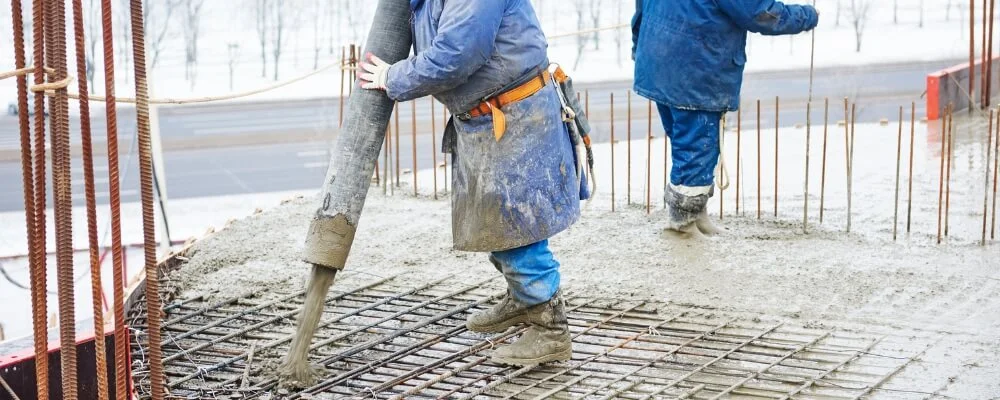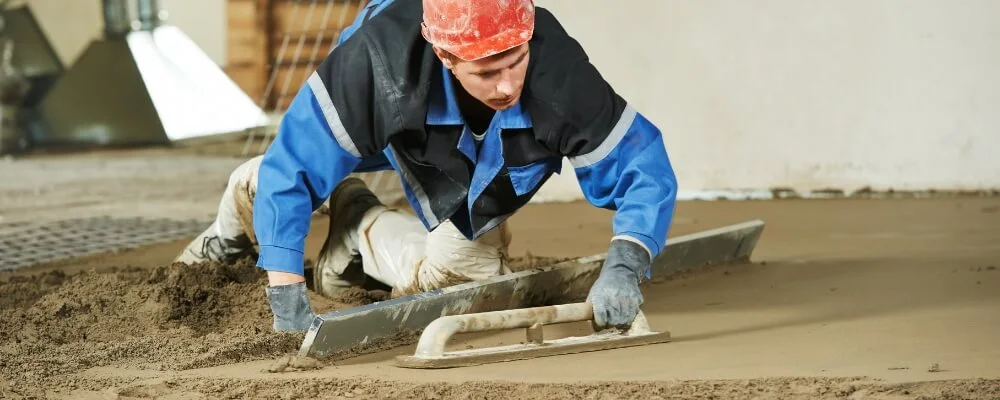The construction industry, particularly concrete work, is fraught with numerous hazards, making it imperative for workers to adhere to stringent safety protocols. Concrete, a fundamental element in construction, is associated with several risks, including chemical burns from its alkaline nature, respiratory issues from dust inhalation, and physical injuries from handling heavy materials and equipment.
Additionally, the environment in which concrete work occurs often presents dangers such as falling objects, slips, trips, and falls, noise pollution leading to hearing issues, and the risk of electrocution due to the proximity of power lines and the use of electrical equipment in wet conditions.
Recognizing these hazards underscores the importance of implementing and following concrete safety tips diligently. These safety tips are not just pivotal in preventing injuries and fatalities. Still, they are also crucial for enhancing productivity, maintaining legal compliance, managing costs efficiently, and fostering a positive reputation for companies in the construction sector.
A commitment to safety also contributes to employee morale and retention and ensures the overall quality of work in construction projects. In this blog, we will delve into the hazards associated with concrete work, discuss the importance of maintaining safety, and explore the top 10 concrete safety tips every worker should know.
Concrete-Related Hazards and the Significance of Safety Measures
Concrete work, while essential in construction, poses several hazards, making the implementation of safety measures crucial. Here’s a detailed look at the hazards associated with concrete and the importance of maintaining safety.

Hazards Associated with Concrete
- Chemical Burns: Wet concrete is highly alkaline and can cause severe chemical burns if it comes into contact with the skin for prolonged periods.
- Dust Inhalation: The inhalation of concrete dust can lead to respiratory problems, including silicosis, a condition caused by inhaling silica dust, which can be debilitating and even fatal.
- Physical Injuries: The handling of heavy concrete materials and equipment can lead to musculoskeletal disorders, strains, sprains, and fractures.
- Falling Objects: In construction sites, there’s a risk of objects falling from a height, which can cause serious injuries to workers below.
- Slips, Trips, and Falls: Wet concrete and cluttered work areas can lead to slips, trips, and falls, resulting in various injuries.
- Noise: The use of machinery and equipment in concrete work can generate high noise levels, leading to hearing loss over time.
- Electrocution: The presence of power lines and the use of electrical equipment in wet conditions can result in electrocution hazards.
Importance of Concrete Safety
- Prevention of Injuries and Fatalities: Implementing safety measures helps in preventing and minimizing the risk of injuries and fatalities in the workplace.
- Enhanced Productivity: A safe work environment fosters well-being and morale among workers, leading to increased productivity and efficiency.
- Legal Compliance: Adhering to safety regulations and standards is a legal requirement, and failure to comply can result in penalties and legal repercussions.
- Cost-Efficiency: Investing in safety reduces the costs associated with accidents, such as medical expenses, compensation, and downtime.
- Reputation Management: Maintaining a safe workplace contributes to a positive reputation, which is vital for attracting skilled workers and securing contracts.
- Employee Morale and Retention: A commitment to safety demonstrates care for the well-being of employees, boosting morale and aiding in the retention of skilled workers.
- Quality of Work: Safety measures ensure that work is carried out under controlled and standardized conditions, contributing to the overall quality of the construction project.
By understanding the hazards associated with concrete work and prioritizing safety, construction companies can create a conducive work environment that protects workers from harm, enhances productivity, and upholds legal and ethical standards.
Top 10 Concrete Safety Tips Every Worker Should Know
Concrete work can be hazardous, and workers must be aware of the safety measures they need to take to prevent accidents. Here are the top 10 concrete safety tips every worker should know:

1. Wear Appropriate Personal Protective Equipment (PPE)
Wearing appropriate Personal Protective Equipment is crucial for concrete workers. Safety goggles are essential as they protect the eyes from splashes of wet concrete and flying particles, preventing eye injuries. Gloves are necessary to avoid direct skin contact with wet concrete, which can lead to chemical burns due to its caustic nature.
A dust mask or respirator is vital to prevent the inhalation of dust particles, which can cause respiratory issues. Additionally, wearing steel-toed boots is important to protect the feet from falling objects and to prevent injuries from stepping on sharp objects.
2. Proper Lifting Techniques
Using proper lifting techniques is essential to avoid back and musculoskeletal injuries, which are common in jobs that involve lifting heavy objects, such as bags of concrete mix. Workers should bend their knees and keep their backs straight while lifting and should avoid twisting their bodies.
It’s important to seek help from a colleague or use mechanical aids like forklifts or hand trucks when lifting objects that are too heavy to manage alone. This not only prevents injuries but also promotes a culture of safety and teamwork on the worksite.
3. Keep the Work Area Clean and Organized
Maintaining a clean and organized work area is vital to prevent accidents like tripping and falling, which can lead to serious injuries. Workers should promptly remove any tools, debris, and other tripping hazards from the work area and keep walkways and access areas clear.
A clutter-free work environment promotes efficiency and reduces the risk of accidents, creating a safer and more productive workspace for everyone involved.
4. Use Tools and Equipment Safely
The safe use of tools and equipment is paramount in preventing accidents and ensuring the well-being of workers. Regular inspection of tools and equipment is necessary to identify and rectify any defects or malfunctions that could lead to accidents.
Workers should always use tools and equipment according to the manufacturer’s instructions and should be trained adequately on their proper use. This ensures that the tools and equipment are used effectively and safely, reducing the risk of injuries.
5. Avoid Skin Contact with Wet Concrete
Avoiding skin contact with wet concrete is crucial as it can cause chemical burns due to its alkaline nature. Workers should be diligent in avoiding direct skin contact and should wash their skin promptly with water if it comes into contact with wet concrete.
It’s also important to change into clean clothes if wet concrete splashes onto clothing to avoid prolonged skin contact. Awareness and immediate action are key in preventing skin-related injuries and conditions associated with exposure to wet concrete.
6. Stay Hydrated and Take Regular Breaks
Staying hydrated is crucial, especially for workers engaged in physically demanding tasks like handling concrete, particularly in hot weather. Dehydration can lead to heat-related illnesses such as heat exhaustion and heat stroke, which can be severe and life-threatening.
Drinking plenty of water throughout the day is essential, and workers should also take regular breaks in shaded areas when working under the sun to cool down and recover. These practices are vital in maintaining the well-being and productivity of workers in the construction environment.

7. Secure the Work Area
Securing the work area is a fundamental safety practice in concrete work. The use of barriers and signs is essential to keep unauthorized persons and bystanders away from the work area, minimizing the risk of accidents involving non-workers.
Additionally, securing loose objects that could fall or be knocked over is crucial to prevent injuries to workers and damage to equipment. A secure work area ensures a controlled and safe environment, reducing the likelihood of unforeseen incidents and promoting overall safety on the worksite.
8. Be Aware of Surroundings
Being aware of one’s surroundings is crucial in a dynamic environment like a construction site. Workers should be mindful of moving equipment and vehicles in the work area to avoid collisions and accidents.
Additionally, staying alert to potential hazards such as overhead power lines and underground utilities is essential to prevent electrocutions and other serious incidents. A heightened sense of awareness and attentiveness to the environment enables workers to react promptly to potential dangers, enhancing safety on the worksite.
9. Follow Lockout/Tagout Procedures
Following lockout/tagout procedures is essential when servicing equipment to ensure that all energy sources are isolated, preventing unexpected equipment start-up. These procedures are critical in avoiding accidents such as crush injuries, amputations, and electrocutions.
Workers should be trained on proper lockout/tagout procedures and should strictly adhere to them to ensure their safety and the safety of their colleagues. Compliance with these procedures is a fundamental aspect of maintaining a safe working environment in industries involving the use of heavy machinery and equipment.
10. Get Proper Training
Receiving proper training is paramount for every worker involved in concrete work. Training should encompass the safe use of tools, equipment, and materials, enabling workers to perform their tasks efficiently and safely.
Additionally, workers should be knowledgeable about emergency procedures and first aid to respond effectively in case of accidents or health emergencies. Proper training equips workers with the knowledge and skills they need to avoid hazards, mitigate risks, and ensure their safety and the safety of their colleagues in the workplace.
Conclusion
The inherent hazards associated with concrete work necessitate a rigorous adherence to safety protocols and practices. The alkaline nature of wet concrete, the inhalation of dust, and the physical demands of handling concrete materials underscore the myriad of risks present in this sector of the construction industry. By acknowledging and addressing these risks through the implementation of concrete safety tips, workers can significantly mitigate the occurrence of injuries and fatalities.
The importance of safety in concrete work extends beyond individual well-being, impacting overall productivity, legal compliance, cost efficiency, company reputation, and the quality of construction projects. It is paramount for every worker to be well-acquainted with and diligently apply the concrete safety tips discussed, fostering a safer and more conducive working environment for all involved in the realm of concrete and construction work.

